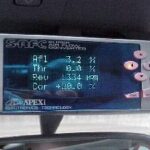Mileage correction, also known as odometer correction, is a process of adjusting a vehicle’s displayed mileage using specialized tools, often via the OBD2 port. This article provides a comprehensive overview of mileage correction using OBD2, outlining supported vehicle makes and models, as well as the functionalities offered by various tools.
Understanding Mileage Correction via OBD2
OBD2, or On-Board Diagnostics II, is a standardized system that allows external devices to access a vehicle’s computer system for diagnostics and modifications. Mileage correction tools utilize this port to communicate with the vehicle’s odometer module and adjust the stored mileage value. While the legality of mileage correction varies depending on local laws and intended use, it’s commonly employed for legitimate purposes like instrument cluster replacements, ECU swaps, and testing.
Supported Vehicle Makes and Models for Key Programming and Mileage Correction
A wide range of vehicle manufacturers and models are compatible with OBD2 mileage correction tools. The following list highlights some of the most commonly supported brands:
- European Vehicles: Audi, BMW, Benz, Volkswagen, Seat, Skoda, Porsche, Fiat, Citroen, Peugeot, Renault, Dacia, Jaguar, Land Rover, Mini, Opel, Volvo, Smart, Alfa Romeo, Iveco.
- Asian Vehicles: Honda, Acura, Toyota, Lexus, Nissan, Infiniti, Mitsubishi, Subaru, Suzuki, Mazda, Kia, Hyundai, Ssangyong, Daewoo, Isuzu, Geely, Byd, Great Wall, Roewe, Zotye, Chery.
- American Vehicles: Ford, Chrysler, Dodge, Jeep, GM (including Chevrolet, Buick, Cadillac), and more.
Note: Support for specific models and model years can vary depending on the mileage correction tool used. Always consult the tool manufacturer’s compatibility list before attempting any adjustments.
Key Programming and Special Functions via OBD2
Beyond mileage correction, many OBD2 tools offer additional functionalities, including:
Key Programming:
- Programming and erasing keys
- Programming remote keys
- Reading PIN codes
- Retrieving key numbers
- Reading EEPROM chip data
Special Functions:
- ABS bleeding
- Gear learning
- CVT reset
- Battery matching
- EPB (Electronic Parking Brake) service
- TPS (Throttle Position Sensor) adjustment
- Steering angle reset
- DPF (Diesel Particulate Filter) regeneration
- Oil nozzle code reset
- Suspension reset
Mileage Correction Functionalities
Mileage correction tools offer various functions specifically for odometer adjustment:
- Write Odometer: Directly modify the stored mileage value.
- Read Flash: Access and read the vehicle’s flash memory.
- Write Flash: Write data to the vehicle’s flash memory.
- Read EEPROM: Access and read data from the EEPROM (Electrically Erasable Programmable Read-Only Memory).
- Write EEPROM: Write data to the EEPROM.
- One-Click Upgrade: Update the tool’s software for improved functionality and vehicle coverage.
Considerations and Precautions
- Legality: Always verify the legality of mileage correction in your jurisdiction and ensure its intended use complies with local laws.
- Professional Use: Mileage correction procedures often require specialized knowledge and equipment. Consult a qualified automotive technician for assistance if needed.
- Tool Selection: Choose a reputable mileage correction tool from a trusted manufacturer to ensure compatibility and reliable performance.
Conclusion
Mileage correction using OBD2 tools offers a versatile solution for adjusting vehicle mileage in specific situations. Understanding the supported vehicles, functionalities, and legal implications is crucial for responsible and effective use. By adhering to best practices and consulting with qualified professionals when necessary, mileage correction can be performed safely and accurately.

